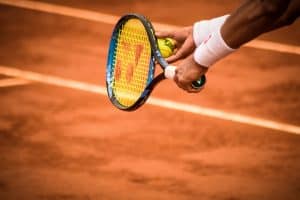The Six Pieces of Tennis Equipment Needed In Your Bag
There are six pieces of tennis equipment needed by most players before heading out to the tennis court. While only two are necessary: a tennis racket (1) and tennis balls (2), a person can fill their tennis bag (3), with plenty more items than six. While the basics also include grips (4), dampeners (5), and hydration (6), many players will also include a backup racket in case their strings break, strings, sunscreen (always a good idea), a sports drink, a towel, and grommets.

The Almighty Tennis Racket
The tennis racket is the single most important, personal, and probably expensive piece of equipment a tennis player will own. There are many factors to consider when deciding on a tennis racket. Size, weight, feel, balance, composition, and even flexibility are all considerations when deciding on a tennis racket.
When starting out, feel (and price) are the only considerations that really matter.
The cost of your first racket should be kept low, as the more expensive rackets will have more distinctions between them that experience will allow you to use to your advantage. Until that point, the choice is yours on what to spend but you can get a racket that’ll hit a tennis ball for as little as $20-25 for an adult, closer to $10-$15 for juniors.
Most clubs will have loner rackets for those in need of one for their match that day. It’s best to call in advance to make sure one is available before heading down there without a racket.
For those willing to spend a little more, the choices grow with the cost. The weight and balance of the racket are big factors to consider for the feel of a racket. The flexibility will effect power versus control, and the size of the racket will give you both advantages and disadvantages in control as well.

I’ve Got Three Tennis Balls
Tennis balls are the 2nd most important thing to bring to the tennis court. Without a racket, you play handball. Without the balls, your swatting at flies. Bring the balls!
The decision on who is to supply the balls should be made before meeting for the match. It’s best to take alternating turns when playing with a regular partner. When playing with a new partner, the person who initiated the match should provide the balls. It may be good etiquette if you are an invited guest to a private club to offer to buy the balls, especially if the host picks up the guest fee.
There are many versions of tennis balls, but for a beginner, it will not matter as long as they bounce and are for tennis. The different versions include practice balls, pressurized, non-pressurized, light duty, extra duty, and more. The basic can of three tennis balls, no matter the brand, will do just fine. Notice that original smell when you first open a can. It’s a tennis players delight.
Bag It
The tennis bag is a great item to have to store all of the tennis equipment needed. While the racket and balls are the only truly necessary items, the bag will help you with every item a tennis player will need. There are unlimited choices for sizes, patterns, storage, and more for tennis bags. Keep it sensible for your needs, and you really don’t need one when you are first starting out.

Get a Grip
Every racket must have a grip, and every player must grip their racket. The first factor to consider when choosing a grip is: does your racket need a replacement grip or an overgrip?
The replacement grips are thicker than an overgrip, meant to completely replace the grip that your racket is manufactured with. You will have to remove the grip that is currently on the racket before replacing it with a new one. These come with or without perforation, with or without ribbing, and different materials and thicknesses are used for different feels.
An overgrip is meant to wrap around a replacement or original grip. Perforation, material, tackiness, softness, and thickness are all variations for an overgrip.
If you need to replace your grip or overgrip, be sure to follow instructions. Inspect your grip before your match or practice session. If it needs replaced, follow proper grip replacement instructions. Doing so will avoid unraveling and unnecessary tearing of your grip.
Dampen the String Vibration
A dampener may help limit the vibration your hand feels when you hit the tennis ball. The dampener is a little rubber or silicone piece that fits in between your strings on the second or third pattern of strings away from the throat of the racket, centered. Over the long haul of a match, your wrist might thank you for the damage you didn’t cause it by using one of these cost effective, handy dandy little items.
 Hydrate
Hydrate
Maybe the most essential item you can have while playing any sport is hydration. While you can certainly play tennis without water, your body will not like you as you risk dehydration, injury, illness, and worse by not providing fluids for you body. Whether that hydration is water, a sports drink or something else, keep it with you anytime your at the courts. Proper hydration is imperative for you body and your health, so please do not neglect this piece!
Bring the Gear, Bring the Game!
These six pieces of tennis equipment needed by most players: a tennis racket, tennis balls, a tennis bag, tennis grips, racket dampeners, and hydration. They are the basics for any tennis player to match up and play with focus and passion. Have fun!

